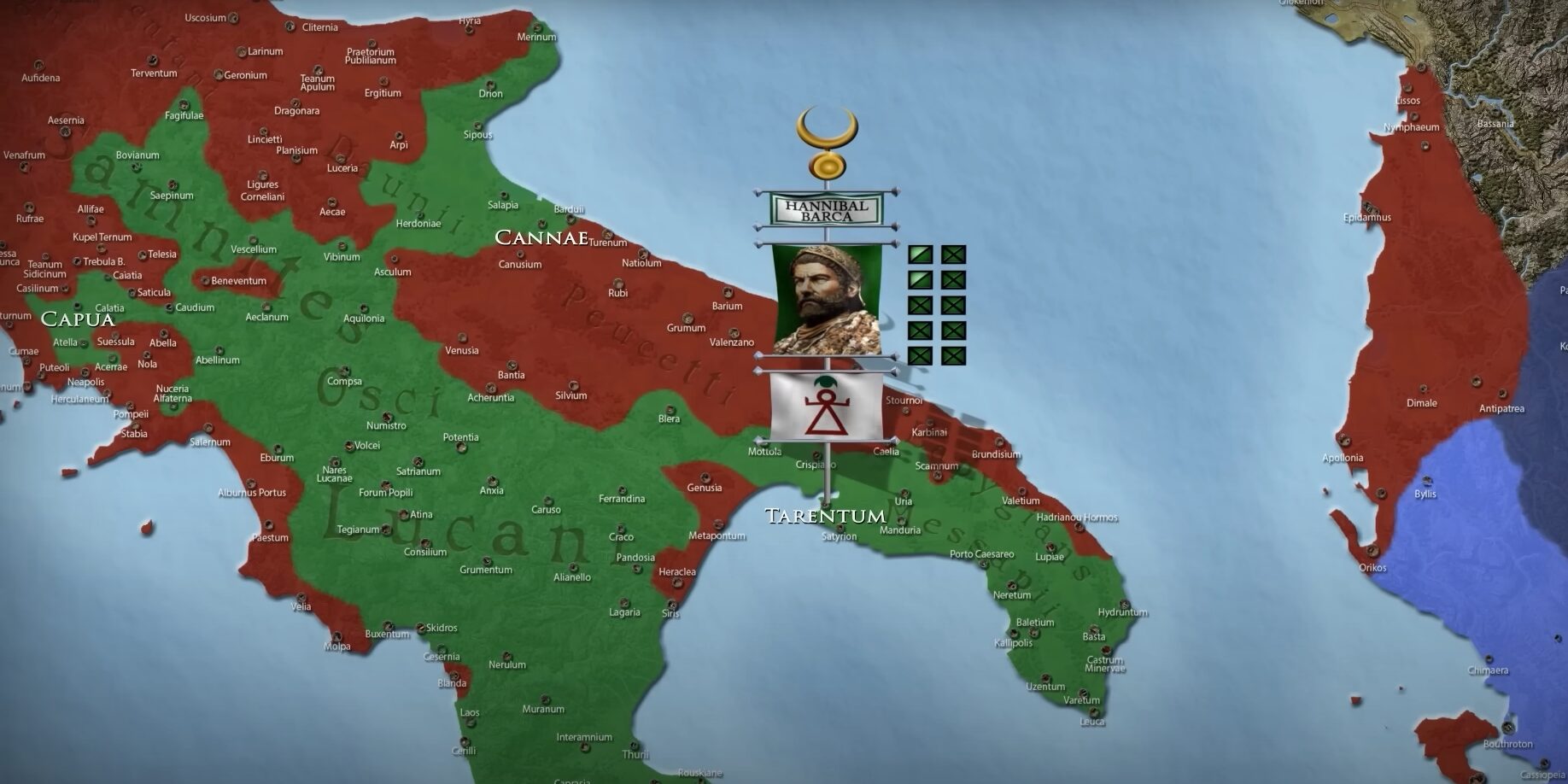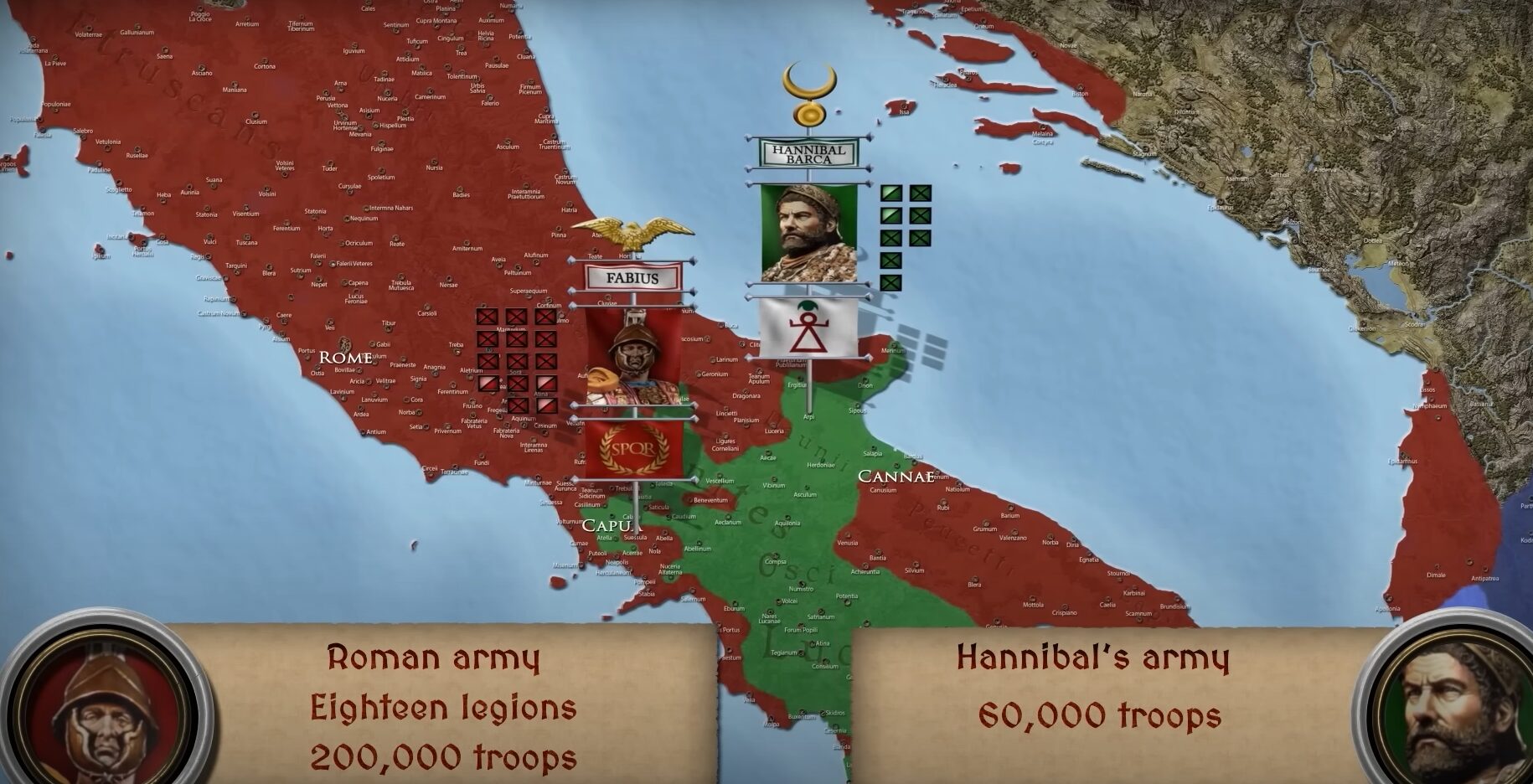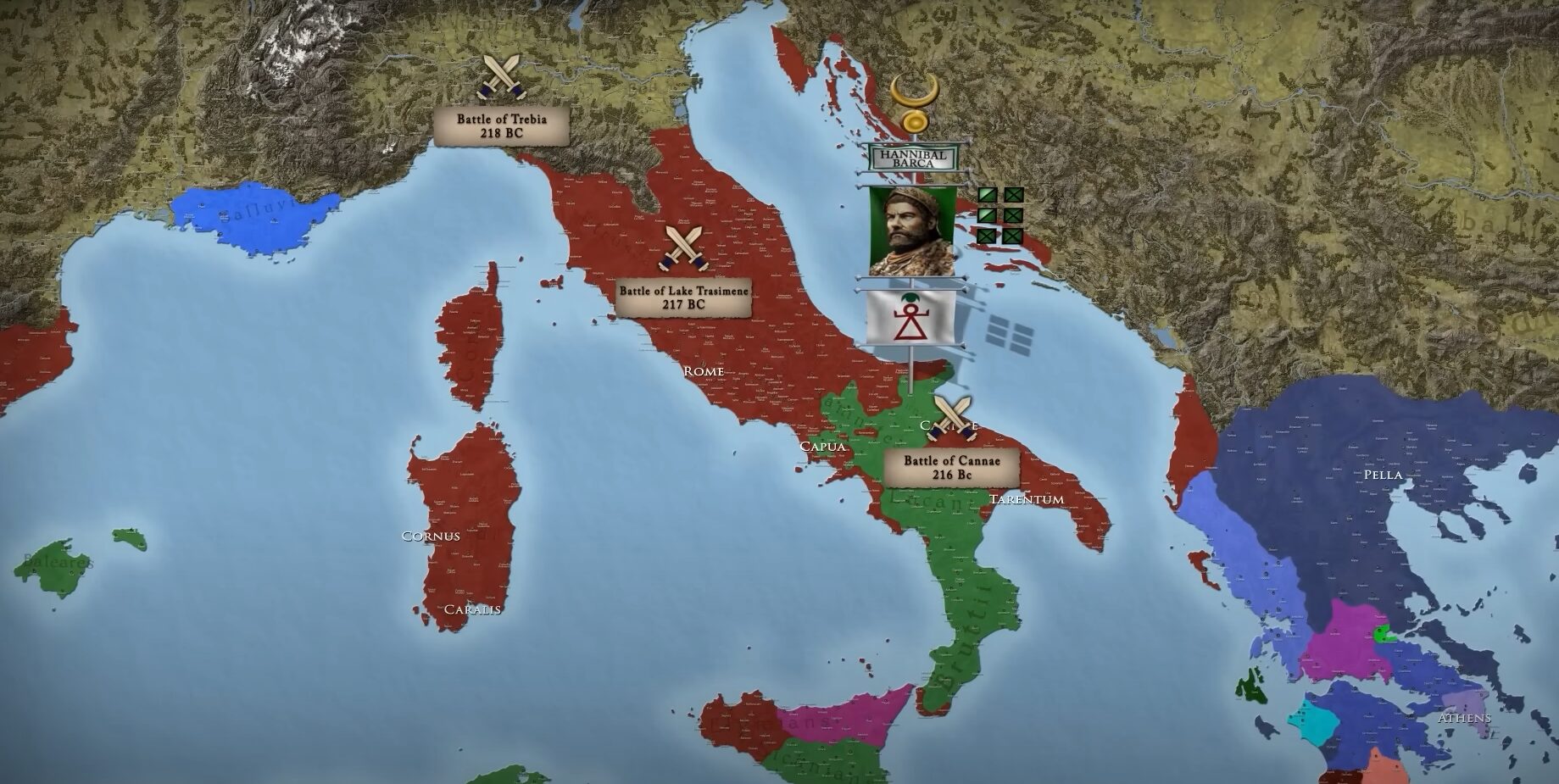In early 214 BC, Hannibal was still a significant threat in Southern Italy, despite facing a shortage of resources and support from Carthage. His experienced army had outmaneuvered the Romans for years, but Rome’s determination and ability to raise new forces remained strong. The Romans increased their military presence, while Hannibal continued to look for ways to keep his campaign going.
During this time, fear and uncertainty affected both sides. Religious omens shook Roman morale and delayed crucial decisions. In the south, shifting alliances among Italian cities, like Tarentum, opened new opportunities for Hannibal, even as Rome expanded its navy and army to challenge Carthaginian control. The stage was set for another year of hard fighting and changing fortunes.
Key Takeaways
- Hannibal’s campaign in Southern Italy faced new Roman military pressure.
- Shifting city alliances changed the balance of power in the region.
- Rome expanded its naval and army forces to counter Hannibal’s moves.
Hannibal’s Operations in Southern Italy
Outcomes Following Key Battles
After winning major battles like Trebia, Trasimene, and Cannae, Hannibal secured his hold in the south of Italy. Despite this success, many years of hard fighting took a toll on his experienced soldiers. Some of these men had served with him for seven years, fighting from Iberia, through Gaul, and across the Alps.
The Romans, however, were not defeated. Their generals rebuilt shattered armies and maintained strong defenses, even during times of crisis and confusion. Strange events—like a woman turning into a man, or animals speaking—caused panic among the Romans, who paused government business to perform extensive rituals. Only after restoring what they believed was peace with the gods did they return to planning against Hannibal.
Condition of the Carthaginian Forces
By early 214 BC, Hannibal’s army was weary. Most had seen continuous service for years, and support from Carthage was limited. Food and supplies were carefully stockpiled, and garrisons in Campania were doubled to secure key areas. Fortifications were strengthened so that they could withstand attacks.
Even with all this, Hannibal’s forces were much smaller than the Roman armies. He had only about 60,000 troops in total, while Romans could field around 200,000 soldiers across all regions. Still, Hannibal had a reputation for outsmarting larger Roman forces using clever strategies. He used mind games to keep Roman generals cautious. Passing close to enemy camps, he made his rivals fear ambushes, causing them to hesitate instead of attacking.
Strengths of Hannibal’s Army:
- Experienced soldiers with years of battle.
- Solid defenses and well-supplied bases.
- Leadership known for strategic risk-taking.
| Aspect | Hannibal’s Army | Roman Armies |
|---|---|---|
| Size | ~60,000 | ~200,000 |
| Support from home | Limited | Extensive |
| Experience | Very high | Mixed |
| Supplies | Carefully managed | Well provided |
Rome’s Recovery and Military Renewal
In reply to early defeats, Rome did not give up. They quickly formed new legions. By January, the Republic had recruited six more, bringing the total to eighteen legions in the field. This was a powerful force, especially given that their leaders now used new tactics and learned from earlier mistakes.
The Romans also improved their navy, creating a fleet of about 150 warships mostly based in Bruttium and Sicily. For the first time, these ships were crewed by paid professionals, not just citizen sailors. Wealthy Romans funded the salaries to avoid any risk of mutiny.
While the Roman army was much larger, the fear and suspense Hannibal created continued to affect their decisions. Rome’s leaders took extra care, sometimes stopping advances because of fears about deception and traps. Even so, they were able to take back cities like Aecae and Asculum when Hannibal was drawn away by events elsewhere.
List of Roman Improvements:
- Raised more legions for larger field armies.
- Rebuilt and restaffed the navy with professional sailors.
- Responded to threats with quick, large-scale actions.
Tactical Shifts and Heightened Suspicion

Hannibal’s Actions in Southern Italy
Hannibal remained active in southern Italy, adapting his tactics despite dwindling support. Facing armies much larger than his own, he gathered his forces in Apulia during the winter, but quickly redirected towards Campania after urgent requests reached him from Capua.
His march was bold. Hannibal brought his troops dangerously close to a Roman camp near Luceria. The Roman soldiers could see his men, and some were eager to fight, thinking the Carthaginian line was exposed. Hannibal’s presence was not an accident; it was a calculated move meant to make his enemies hesitate.
He continued to confuse his opponents by pillaging the land near Benevento, drawing the Roman armies out without ever committing himself to a risky battle. Whenever he moved, he chose routes and actions that forced the Romans to second-guess his intentions.
| Action | Outcome |
|---|---|
| Close march by Luceria | Romans held back out of caution |
| Rapid response to Capua | Campaigns redirected, plans changed |
| Pillaging near Benevento | Provoked but did not engage |
At the same time, Hannibal’s relationships with local leaders paid off. Certain nobles from Tarentum reached out, promising support if he neared their city. Hannibal welcomed these offers, further undermining Rome’s control over the region and keeping his options flexible with local alliances.
Roman Reactions and New Policies
Roman leaders became cautious. Recent defeats haunted their decisions, and suspicion of ambush shaped their every move. Generals like Gracchus often avoided battle, fearing that Hannibal’s bravado was a trick. Even when there was no trap, this constant doubt gave Hannibal extra breathing room.
Strange events added to the Romans’ worries. There were public reports of unnatural signs and omens: odd happenings like animals speaking and bizarre transformations. These superstitions shook confidence within the state and caused weeks of delay while ceremonies and rituals were performed.
- Leadership responses:
- Avoided confrontations near Luceria and Benevento
- Followed strict orders to not pursue Hannibal too far
- Paused government business over fear of divine anger
Meanwhile, the Romans took practical steps to recover control. They built up their armies to unprecedented levels, fielding around 200,000 men across multiple regions. The navy saw expansion too, with new funding and a switch to hiring full-time sailors. These decisions aimed to guard against Hannibal on land and at sea, and to prevent further surprises.
Despite nearly overwhelming resources, Roman leaders continued to walk carefully, unable to shake the fear that any bold move might end in disaster.
Signs From The Gods And The Confidence Of Rome
Influence Of Divine Warnings On Government
Strange events unsettled the Romans in this period. People reported a woman changing into a man, a crow nesting in a temple, and even animals speaking like people. A tree seemed to catch fire on its own. These were seen as warnings from the gods.
These omens caused the Roman Senate to stop meeting for weeks. Leaders believed that ignoring the gods could bring disaster, especially during war. Rituals and ceremonies took place until religious experts said the gods were calm again.
Roman Response To Omens:
| Omen | Response |
|---|---|
| Woman turns into a man | Ritual performed |
| Crow in temple | Ritual performed |
| Speaking animals | Ritual performed |
| Tree catches fire | Ritual performed |
Securing The Gods’ Favor Again
Priests and soothsayers were called to make sense of the strange signs. Special rites aimed to regain the peace with the gods before state decisions continued. Only after these steps did officials feel safe enough to focus on military threats.
Key steps for restoring favor:
- Pause all official meetings
- Gather religious leaders
- Perform ceremonies and sacrifices
- Confirm that the gods are at peace
Once these steps were complete, attention turned back to plans for dealing with enemy commanders. The state would not act until the sense of religious safety was restored.
Changing Southern Italian Alliances

Capua’s Request and Its Aftermath
In early 214 BC, Capua saw the growing number of Roman soldiers near Campania as a direct threat. Worried that Rome might punish them for siding with Carthage, leaders from Capua sent an urgent message to Hannibal, asking for his help.
Hannibal quickly changed his plans for the year and moved his army from Apulia toward Campania, calling for support from Hanno’s forces in Bruttium. On his way, he boldly marched close to a Roman camp, testing whether the Romans would attack while he was on the move. The Roman commander, Gracchus, however, suspected a trap and held back. This delay allowed Hannibal to continue without a fight.
By the time Hannibal reached Capua, he learned that the threat was less serious than Capua’s leaders had claimed. He had already prepared the area with strong defenses and stocked supplies the year before. The recall from Apulia, based on Capua’s fear, cost Hannibal his chance to carry out his campaign in that region.
Key Effects:
- Wasted time and lost opportunities in Apulia
- Let Romans regain ground in key areas
Defensive Work and Roman Progress in Apulia
When Hannibal left Apulia to help Capua, Roman forces used the opportunity. Quintus Fabius, son of Fabius Maximus, quickly moved to capture the towns of Aecae and Asculum.
Meanwhile, Hannibal’s earlier efforts in Campania paid off. He had:
- Doubled garrisons in important cities
- Improved city walls and defenses
- Gathered enough food to withstand a long siege
He attempted to secure a port closer to Capua by laying siege to Puteoli and attacking the local countryside. While he was away from Apulia, though, the Romans strengthened their control in that region.
| Side | Action | Result |
|---|---|---|
| Carthage | Strengthened forts in Campania | Defenses better, plan delayed |
| Rome | Captured two Apulian cities (Aecae, Asculum) | Gained territory and morale |
Roman forces also took advantage of Hannibal’s absence, making steady progress in Apulia while he focused on Campania’s safety. This shift in focus shaped the alliances and control in southern Italy during this period.
Hannibal’s Operations in Campania
Blockade of Puteoli and Regional Moves
Hannibal responded swiftly to urgent requests from Capua, bringing his forces into Campania despite worn-down troops and limited support. Once there, he found the situation less critical than expected, as he had already prepared local defenses and supplies the previous year.
He shifted his focus by attempting to blockade the city of Puteoli, aiming to secure a nearby harbor for his base at Capua.
- Key Actions:
- Doubled regional garrisons
- Strengthened local fortifications
- Stockpiled provisions for a year
- Attempted to blockade Puteoli
- Looted the countryside to provoke Roman forces
Even with fewer men, his strategic movements kept Roman generals cautious and hesitant to attack.
| Hannibal’s Tactics | Roman Reactions |
|---|---|
| Reinforcing defenses | Increased local garrisons |
| Stockpiling resources | Built up Roman forces |
| Provoking engagements | Avoided direct conflict |
Meeting with Greek Leaders from Tarentum
While near Puteoli, Hannibal was visited by five nobles from Tarentum. These leaders were once Roman allies but had suffered under Roman demands for troops, ships, and tribute.
The nobles told Hannibal there was growing support for Carthage in their city. They believed that if Hannibal appeared near Tarentum, the city gates would be opened for him.
- Background on Tarentum:
- Once a major Greek power in southern Italy
- Forced into an unfavorable alliance with Rome
- Still resentful over harsh Roman policies
Hannibal listened carefully and assured the nobles that he would soon support them. This meeting set the stage for more collaboration between Carthage and local Greek leaders, highlighting the discontent many communities felt under Roman rule.
Tarentum’s Shifting Power Structure

Roman Control and Local Frustration
Tarentum was once a leading city in southern Italy, well known for its strong economy and important harbor. After the city lost its independence, Rome forced strict terms on the people. They had to allow a Roman garrison inside their walls, send soldiers and ships to support Roman wars, and pay a yearly tribute.
Many locals still remembered the time before Rome took over. Resentment grew each year as Tarentines saw themselves losing wealth and control. Their city was pulled deeper into the Roman system, and their own traditions and rights began to fade.
| Roman Demands | Tarentine Response |
|---|---|
| Host Roman soldiers in the city | Frustration and bitterness |
| Pay annual taxes to Rome | Complaints about unfairness |
| Fight in Roman wars | Desire for greater freedom |
Hopes Rising for Change in Tarentum
Several important families in Tarentum began to see new possibilities. They had met Hannibal before, and he had treated them fairly when other Romans would not. These nobles believed that if Hannibal came to their city, many would support a switch in loyalty.
They promised that if Hannibal arrived near the city, the gates could be opened for him. A growing number of people in Tarentum wanted to break free of Roman rule and saw an alliance with Carthage as their best hope for greater independence.
- Nobles promised support to Hannibal
- Growing support for Carthage inside the city
- Hopes for more freedom and self-rule with a new alliance
Growth of Rome’s Sea and Land Forces
Improvements to Roman Warships
The Roman Senate increased naval power by adding more warships, reaching a total of about 150 vessels. Most of these ships were placed in the regions of Bruttium and Sicily.
For the first time, the navy was staffed by professional sailors instead of soldiers or less-experienced crews. To make sure these sailors were paid on time, the Senate required Rome’s wealthy citizens to fund their salaries. This helped keep the fleet active and reduced the risk of unrest among the crews.
Key Points:
- Over 150 warships in service
- Stationed mainly near Bruttium and Sicily
- Professional seamen hired
- Salaries paid by Rome’s elite class
Steps to Counter Sea Dangers
Roman leaders saw that a possible alliance between the Carthaginian navy and the Syracusan fleet could threaten Rome’s supply lines and control of the seas around Sicily. By keeping their fleet ready and staffed with trained sailors, they aimed to cut off support to Hannibal and prevent enemy control over the region.
A table of Roman priorities in military expansion:
| Goal | Action Taken |
|---|---|
| Secure trade and supply routes | Strengthen the navy |
| Prevent Carthaginian sea dominance | Station fleets in key areas |
| Avoid mutinies | Ensure regular sailor pay |
| Guard against new threats | Keep fleet in constant readiness |
With these actions, the Romans placed a strong focus on building and maintaining both their navy and their land armies to meet threats from multiple directions.
Current Struggles and Battlefield Results
Advance Toward the Greek City
Hannibal’s forces moved carefully through southern Italy, making their way toward the important city by the coast. Along the route, the army stayed close to Roman camps, tempting the enemy to attack. Roman leaders, remembering past tricks, hesitated—unsure if they were walking into an ambush.
This caution allowed Hannibal’s columns to march unchallenged, despite being in plain view. His actions caused confusion and doubt among the Roman commanders, freezing them into inaction. While Hannibal pressed forward, he also made contact with leading citizens inside the city, who offered their support and promised to open the gates if he appeared with his army.
| Side | Goal | Tactics Used |
|---|---|---|
| Carthage | Win Greek support | Daring marches, negotiation |
| Rome | Argue for Roman loyalty | Defensive stance, suspicion |
Clashes Near the Campanian Settlement
On the way, Hannibal stopped near a repeated site of skirmishes in Campania. Here, he worked to break Roman defenses by attacking the edges, trying to find a weak spot. Roman commander Marcellus watched closely but refused to take the bait, holding his legions back and standing firm.
The Carthaginians pushed hard against the city’s sides while keeping a steady line in the center. Despite the noise and pressure of the clash, Roman discipline held. Both sides probed and tested, but no breakthrough was achieved. This pattern showed how tough it was for either side to win a clear victory at this stage.
Key Points:
- Hannibal attempted to outmaneuver the Romans but faced strong resistance.
- Roman commanders chose caution over risky attacks.
- Ongoing battles kept both armies locked in a tense struggle.

I like the efforts you have put in this, regards for all the great content.
I am truly thankful to the owner of this web site who has shared this fantastic piece of writing at at this place.